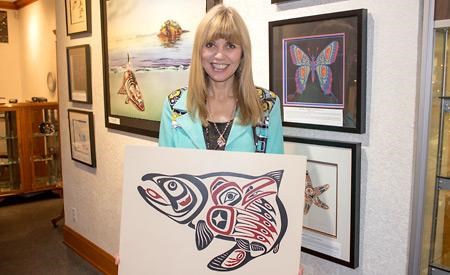April White’s acrylic painting Salmon Tale has won Pacific Salmon Foundation’s art contest.
The decision was announced in a press release from the foundation. By winning, White’s painting will appear on the fishing-licence stamp, an initiative which generates funds for conservation of wild Pacific salmon. Anglers must purchase the Recreational Fisheries Conservation Stamp, known as the “salmon stamp,” and display it on their saltwater fishing licence if they wish to keep Pacific salmon caught off the west coast of BC.
White, whose traditional name is SGaana Jaad, is a Haida Nation artist. She was born on Haida Gwaii and is of the Yahgu’jaanaas Raven Clan. She interprets the natural and mythological world in her art and honours and draws inspiration from her heritage.
This was the fifth time White has entered the Pacific Salmon Foundation competition. It is the first time in 25 years that a person of First Nation descent has won the art contest.
“In a tired moment at the end of the summer bed and breakfast/studio-gallery season, I briefly entertained the thought that I wouldn’t enter the contest again this year; but I found renewed energy with my resolve to continue entering until First Nations’ art was featured on the salmon stamp,” said White. “I am a food fisher and salmon are, from time immemorial to present, integral to the First Nations of the Pacific coast—spiritually, culturally, and for sustenance. We are ‘salmon people.’”
White displays her art in Wind Spirit Gallery on Marine Avenue. She lives in both Powell River and in Masset on Haida Gwaii. She has a bachelor of science degree and worked as a field geologist before becoming a full-time artist.
Her formline painting in traditional red and black depicts how raven came to bring salmon to human beings and why salmon spawn in coastal streams and rivers.
“The Pacific Salmon Foundation is thrilled that for the first time a First Nations’ representation of Pacific salmon will appear on the salmon stamp,” said Dr. Brian Riddell, foundation president and CEO. “More than 200,000 people buy the salmon stamp each year and we know that the artwork on the stamp is a meaningful representation of the significance of Pacific salmon in British Columbia to all anglers. It’s particularly gratifying that April White, a long-time friend of the Pacific Salmon Foundation and five-time entrant in the art contest, has won this historic honour.”
For more information about White, readers can visit her website.
Salmon Tale, description by April White
The young daughter of a powerful chief awoke from a dream crying inconsolably for what she had seen: a great, shining, leaping fish. The chief sought counsel from the wisest Shaman, who said “We have many fish in our Inlet, but none like that. Raven, who lives among the Cedars might know.”
“What she asks for is Chíin~Salmon. In this moon, they swim at the mouth of a mighty river, far away. I will bring one to your village,” said Raven as he flew swiftly away. Diving the instant his keen eyes saw many Salmon, he caught, by chance, the son of the Salmon Chief and swiftly returned. The Salmon rapidly pursued, but soon fell behind.
Raven placed the great gleaming fish before the beaming daughter of the chief. Then he advised the Shaman, “Many Salmon will try to rescue this young Salmon. You must weave a huge net to catch all the fish.” Which they did, but out of respect many were spared, and these swam off to continue their futile search of the forest streams. Grieving, they spawned in the shallows beneath the sheltering arms of Ts’úu~Cedar Tree.
Year after year the next generation continues the search and the people are thankful for their return. This is how Raven came to bring Salmon to Human Beings. They continued to catch only what they needed to feed the village, and the Salmon are honoured by the care with which they are prepared—allowing the complete fish skeleton to be placed back in the water with the belief that their Spirit would rise again and regenerate, ensuring this cycle of life for future generations.



